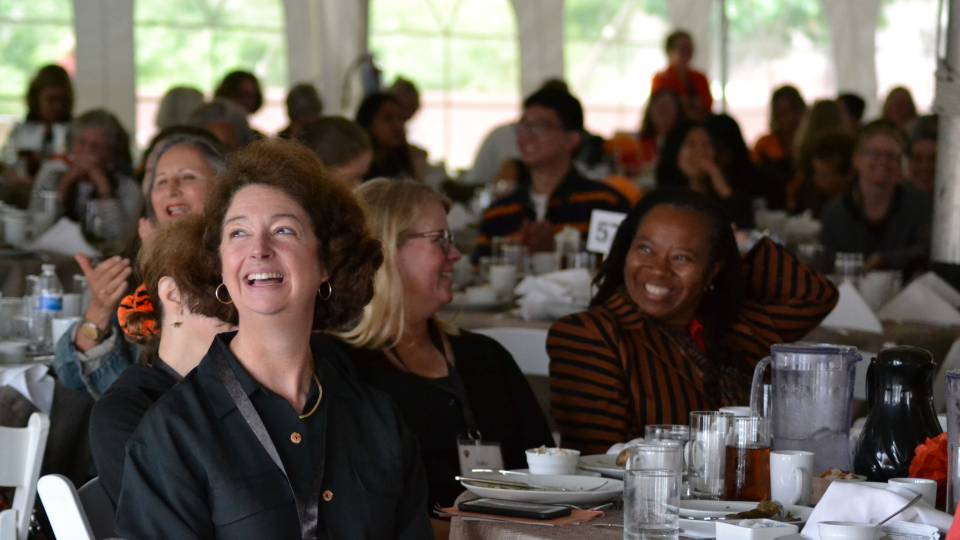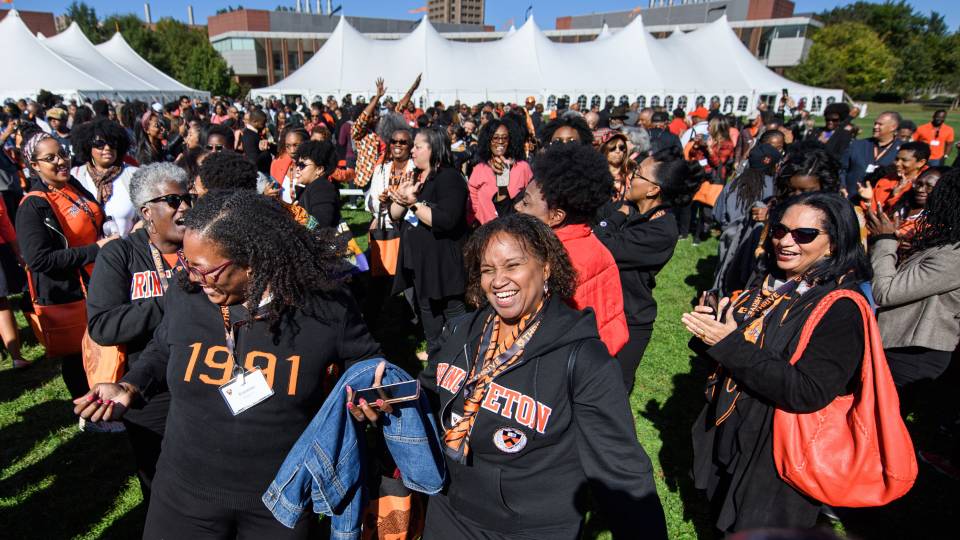Princeton students eat lunch in Frist Campus Center, where the walls are decorated in honor of 50 years of undergraduate coeducation at the University. The exhibit features timelines of significant female firsts, vintage photos of Princeton women and inspirational quotations from trailblazing alumnae.
It’s lunchtime at the Frist Campus Center at the beginning of a new decade. The bustling space is a microcosm of the Princeton academic community. People from every imaginable background, students and faculty, boisterous groups and solitary studiers relax and refuel during breaks in their demanding schedules. In 2020, it’s a setting you might expect at any university in the country, but the walls around this particular scene are a reminder of a different chapter of Princeton’s history.
The walls of Frist’s dining area are decorated to honor 50 years of undergraduate coeducation, with timelines of significant female firsts, vintage photos of determined young faces and inspirational quotations from trailblazing alumnae.
The exhibit on the lower level of Frist is titled “Sis! Boom! Ah!” It features striking black-and-white images of such accomplished Princeton women as U.S. Supreme Court Justices Sonia Sotomayor and Elena Kagan, President Emeritus Shirley M. Tilghman, and former First Lady Michelle Obama.
Upstairs, in a separate display titled “Reflections of 50 Years of Undergraduate Women at Princeton,” alumnae recall just how much has changed since 1969. In her essay for the exhibit, Robin Herman, Class of 1973, who later broke glass ceilings as a sports journalist, described the discomfort of walking into a dining hall “where boys banged spoons on the wooden tables if they liked how you looked.”
The two exhibits will be on display in Frist through the spring semester, with "Sis! Boom! Ah!" through April and "Reflections of 50 Years of Undergraduate Women" through June.
“This is the legacy that today’s undergraduates, male and female, need to understand: coeducation didn’t just happen,” said Diane Hasling, Class of 1979, who helped organize the “Reflections” display. “It took women feeling uncomfortable in places and being told that they didn’t belong, that they were just here to increase the humanities or to make it easier for the men’s social life. It took all that for the University to get where it is now.”

The exhibit on the lower level of Frist is titled “Sis! Boom! Ah!” In the foreground is a photo of T'sai-Ying Cheng, who earned her doctoral degree in 1964 and was the first woman awarded a Ph.D. from Princeton. In the background is a photo of renowned writer and Nobel laureate Toni Morrison teaching on campus.
Knocking at the door of coeducation
Women had studied as undergraduates at Princeton before, most notably when a small group of female juniors from other institutions arrived in the early 1960s as part of a special program to study critical languages. A group of those students were admitted as seniors when Princeton fully opened its doors to female undergraduates in 1969, and became the first women to receive undergraduate degrees, as part of the Class of 1970. That same academic year, the University also admitted 101 female first-years as members of the Class of 1973. It was a cultural earthquake that would reverberate for decades.
The women who attended Princeton during the first decade of coeducation set precedents with every achievement, and their role as pioneers did not end when they exited campus through FitzRandolph Gate. As alumnae, they continued to push on doors that had previously been closed to women, and the contributions they’ve made helped Princeton evolve into a stronger, more welcoming institution.
Coeducation was already in the air when Susan Craig Scott, Class of 1970, arrived from Manhattanville College in 1968 as one of the critical language students. She and several of her female colleagues wanted to stay for their senior years, but the University was still deliberating. “We were determined that they were not going to turn us down,” said Scott, who became a hand surgeon and served on the Board of Trustees in the 1990s. “We did everything we could think of to make them change their minds.”
Despite her uncertain status, Scott ran for secretary of the Undergraduate Assembly (UGA), and won easily, becoming the first woman both to seek and to win a UGA office. “I think it was basically a vote to move forward on coeducation from the undergraduates, more than a vote for me in particular,” she said.
The University followed through, but there was some resistance. In 1972, a well-funded conservative group called the Concerned Alumni of Princeton (CAP) was established to, in their words, “provide a moderating influence” on the University. CAP was firmly against coeducation and other changes it deemed radical.
“I don’t think I’d ever been in a situation in which there were people out there in the universe that really just didn’t want me to be where I already was, so that was a very strange experience,” said Marsha Levy-Warren, Class of 1973. “My personal reaction to it was to get involved in trying to make the campus more hospitable for women and other people who were diversifying the University population.”
Levy-Warren successfully ran for student government and helped establish the Women*s Center, service that helped her become the first female student to win the University’s Moses Taylor Pyne Honor Prize. “These experiences of feeling effectual helped me feel like I belonged and helped me feel like Princeton was a space that wanted and welcomed its female undergraduates,” said Levy-Warren, who served as a Young Alumni Trustee and later became a renowned psychologist.

In addition to the exhibit on the lower level of Frist, a separate display on the first level titled “Reflections of 50 Years of Undergraduate Women at Princeton,” features thoughts from alumnae on how much has changed since 1969.
Creating her own space
The first classes of Princeton women persevered and ultimately thrived on a campus that in many ways was not yet prepared for them. They were crowded together in dorms, initially in Pyne Hall, and they often discovered there weren’t female bathroom facilities in the buildings where they took classes. Though the faculty was overwhelmingly in favor of coeducation, it was not uncommon for female students to feel ostracized in some classes as the only woman.
On the social front, a number of eating clubs were also slow to adapt. Eva Lerner-Lam, Class of 1976, was sophomore class president in 1974, which meant that she and her fellow class officers were responsible for organizing the entire bicker process. “I was in charge of that and as a girl, I wasn’t even allowed to bicker at seven of the clubs,” she said.
One that allowed women was Campus Club, and it needed new members. Lerner-Lam recruited friends to join her there, and she eventually served as Campus Club president, becoming the first female student to lead a Princeton eating club. “I’m very proud of what I did at Campus Club, but I have to say I didn’t have much of a choice,” said Lerner-Lam, who went on to serve on the Board of Trustees in the 1980s. “I needed a club. There was no club available to me so I helped make one available.”
Changing their tune
The women who graduated in Princeton’s first decade of undergraduate coeducation proved beyond any doubt that they belonged, but as those trailblazers became part of the Princeton alumni community, they had to navigate some deeply entrenched traditions. The alma mater, which was often performed at alumni events, became a specific focus of debate. The original song, “Old Nassau,” written by Harlan Page Peck of the Class of 1862, includes the lyrics, “In praise of Old Nassau, my boys,” and “Her sons will give.”
“It became a mission of mine: until the alma mater welcomes us, we are not fully part of the University,” said Carol Obertubbesing, Class of 1973. “Some men would say, ‘What’s wrong with the alma mater? It’s fine.’ And I’d respond, ‘It says, “Her sons will give.” I am nobody’s son. That makes me feel very unwelcome.’”
In 1987, after the Undergraduate Student Government led by Cece Rey Hallisey, Class of 1988, passed a resolution and the Alumni Council endorsed it with an overwhelming vote, the University officially updated the alma mater, changing the gender-specific verses to “In praise of Old Nassau, we sing” and “Our hearts will give.”
“I remember talking about the alma mater with an Italian American alumnus, and we finally connected,” Obertubbesing added. “It was like he realized that what he had experienced — the discrimination he felt as an Italian American at Princeton back in the 1950s — related to what I was experiencing as a woman.”
Another major milestone occurred in 1991 when Dorothy Bedford, Class of 1978, became the first woman to chair the Alumni Council. The daughter of an alumnus, she dedicated her efforts to making the alumni community more inclusive. “My top priority was revising the Council’s constitution and bylaws to guarantee representation for all minorities by making separate seats available to affiliated groups, including the LGBT community,” said Bedford, who was subsequently hired by the University to plan and direct its 250th anniversary celebration.
Linda Blackburn, Class of 1971, transferred to Princeton from Douglass College in New Brunswick, New Jersey, in part because she knew a Princeton education would give her “a chance to contribute personally to the rights of blacks and the rights of women.” After she graduated, it was several years before she attended Reunions, but when she finally did, the reception she received from the undergraduates convinced her to return. “Apparently, nobody knew that there were black graduates [from 1971],” said Blackburn, who worked at AT&T and IBM and served as president of the Association of Black Princeton Alumni. “I made it my business to march in the P-rade every year after that, because I wanted black students to understand that they belong here, that we have a tradition here.”
It’s a tradition that continues to grow in the Blackburn family: Her daughter graduated from Princeton in 1995, and her granddaughter is a member of the Class of 2023.
Roaring to the top
Today, more women are involved in the Princeton community and its leadership than ever before. On campus, the Undergraduate Student Government has a female president and vice president, and six of the 11 eating clubs are currently led by women. Of the 123 regional Princeton Clubs, 49 are led by female presidents, and in 2019, Louise “Weezie” Sams, Class of 1979, became the chair of the Board of Trustees, succeeding Kathryn Hall, Class of 1980.
The University’s She Roars conferences in 2011 and 2018 were dedicated to the celebration of women at Princeton, and their success helped double the number of regional Princeton Women’s Network groups, which create local communities through grassroots efforts and activities focused on shared interests and issues.
“She Roars encouraged more women to get engaged with alumni leadership and promoted the feeling that Princeton did want them to be part of the alumni body and to contribute to the life of the University,” said Hasling, who co-chaired her class’ 25th Reunion and subsequently served as class president.
Last April, the Princeton Club of Chicago celebrated the 50th anniversary of undergraduate coeducation with its own conference, featuring panelists including historian Nancy Weiss Malkiel, a former dean of the college and author of the 2016 book “Keep the Damned Women Out: The Struggle for Coeducation.” Members of classes from the 1970s through the 2010s — woman and men — spoke about their personal coeducational experiences.
“One of the things that some of us felt very strongly about was that it shouldn’t be just about women, that coeducation did have an impact on men and on the University in general,” said Obertubbesing, who helped organize the conference. “I didn’t want it to be us-versus-them. I wanted it to be very inclusive and as diverse as possible.”
Following Commencement in 1970, FitzRandolph Gate remained permanently unlocked as a symbol of the campus’ new openness. Fifty years later, Princeton is a different place, and not just for its female students. The high standards the first women established at Princeton and the lessons the University learned in making them feel at home have helped make the process easier for each generation of Princeton’s constantly evolving student body.
Levy-Warren returned to teach in Princeton’s Department of Psychology and Program in Women’s Studies, and in the 1990s, she served another term on the Board of Trustees. “For me, Princeton was like being in an intellectual candy store,” she said. “I just loved it — not only the education and the people that I met there, but the ways in which it has shown me how an institution can change, regardless of how difficult that change is.”
To learn more about undergraduate coeducation and history of women at Princeton, see the online tour “Stories of Women at Princeton.”







